Scars, whether from injury, surgery, or skin conditions, can often be a source of self-consciousness and discomfort for individuals. While scars may fade over time, some may remain prominent and affect one’s confidence and quality of life. In recent years, cosmetic surgery has emerged as a viable option for scar removal, offering hope to those seeking to improve the appearance of their skin. In this article, we will delve into the world of cosmetic surgery and explore its potential in removing scars, restoring both physical and emotional well-being.
Understanding Scars: Causes and Types
Before delving into the realm of scar removal, it’s essential to understand the nature of scars themselves. Scars are a natural part of the body’s healing process, resulting from the formation of fibrous tissue (collagen) in response to injury or trauma to the skin. While some scars may fade and become less noticeable over time, others may remain raised, discolored, or uneven, depending on various factors such as the severity of the injury, skin type, and individual healing process.
There are several types of scars, including:
Keloid scars: These are raised, thickened scars that extend beyond the boundaries of the original wound. Keloid scars often result from excessive collagen production during the healing process and may be itchy or tender.
Hypertrophic scars: Similar to keloid scars, hypertrophic scars are raised and may be red or pink in color. However, they remain within the boundaries of the original wound and typically improve over time without treatment.
Atrophic scars: These are indented or depressed scars that result from the loss of underlying tissue, such as in cases of acne or surgery.
Contracture scars: Contracture scars occur when the skin tightens and constricts during the healing process, often resulting from burns or large areas of skin loss. These scars may limit movement and function in the affected area.
The Role of Cosmetic Surgery in Scar Removal
While many scars may fade and become less noticeable with time, others may persist and impact an individual’s self-esteem and quality of life. In such cases, cosmetic surgery offers a range of options for scar removal and improvement.
Surgical Excision: This involves removing the scar tissue and closing the wound with sutures, resulting in a smaller, less noticeable scar. Surgical excision is often used for raised scars, such as keloids or hypertrophic scars, and may be combined with other techniques for optimal results.
Laser Therapy: Laser therapy uses focused beams of light to target and break down scar tissue, stimulating collagen production and promoting the growth of new, healthy skin cells. This non-invasive approach is particularly effective for treating acne scars, as well as certain types of hypertrophic and atrophic scars.
Dermabrasion: Dermabrasion involves removing the top layers of skin with a specialized instrument, such as a rotating brush or diamond-tipped device, to smooth out the surface and reduce the appearance of scars. This technique is commonly used for acne scars and may be combined with other treatments for enhanced results.
Chemical Peels: Chemical peels use a chemical solution to exfoliate the skin and stimulate cell turnover, resulting in smoother, more even-toned skin. While chemical peels are primarily used for cosmetic purposes, they may also be effective in reducing the appearance of certain types of scars, such as superficial acne scars.
Filler Injections: Injectable fillers, such as hyaluronic acid or collagen, can be used to plump up depressed scars and improve their appearance. While filler injections offer temporary results, they provide an immediate improvement in the texture and contour of the skin, making them a popular choice for scar revision.
Factors to Consider Before Undergoing Scar Removal Surgery
While cosmetic surgery offers promising solutions for scar removal, it’s essential to consider several factors before undergoing any procedure:
Severity of the Scar: The type, size, and location of the scar will influence the choice of treatment and the expected outcome. Some scars may respond well to non-invasive treatments, while others may require surgical intervention for optimal results.
Skin Type and Sensitivity: Individuals with certain skin types, such as darker skin tones, may be at a higher risk of developing keloid or hypertrophic scars. It’s important to discuss your skin type and any concerns with your healthcare provider before undergoing scar removal surgery.
Health Status: Pre-existing medical conditions, medications, and lifestyle factors can affect the body’s ability to heal and respond to surgical procedures. Be sure to disclose any relevant medical history and medications to your healthcare provider to ensure a safe and successful outcome.
Expectations and Goals: It’s essential to have realistic expectations about the results of scar removal surgery. While cosmetic procedures can improve the appearance of scars, they may not completely eliminate them. Discuss your goals and expectations with your healthcare provider to ensure they align with the potential outcomes of the procedure.
Recovery and Downtime: Depending on the type of procedure, recovery time may vary, ranging from a few days to several weeks. Be prepared to follow post-operative care instructions and allow adequate time for healing and recovery before resuming normal activities.
Conclusion: Empowering Individuals with Options for Scar Removal
In conclusion, cosmetic surgery offers a range of options for scar removal and improvement, providing hope and confidence to individuals seeking to address the visible signs of scarring. Whether through surgical excision, laser therapy, dermabrasion, chemical peels, or filler injections, these procedures can help restore both physical appearance and emotional well-being.
However, it’s essential to approach scar removal surgery with careful consideration, taking into account factors such as the severity of the scar, skin type, health status, expectations, and recovery time. By working closely with a qualified healthcare provider, individuals can make informed decisions about their treatment options and achieve the desired results safely and effectively.
Ultimately, scar removal surgery empowers individuals to reclaim control over their appearance and embrace a renewed sense of confidence and self-assurance. As advancements in cosmetic surgery continue to evolve, the future holds promise for further innovations and improvements in scar removal techniques, offering new possibilities for individuals seeking to overcome the visible reminders of past injuries and traumas.
[inline_related_posts title=”You Might Be Interested In” title_align=”left” style=”list” number=”6″ align=”none” ids=”7075,7072,7019″ by=”categories” orderby=”rand” order=”DESC” hide_thumb=”no” thumb_right=”no” views=”no” date=”yes” grid_columns=”2″ post_type=”” tax=””]
































